Customer Satisfaction: A Comprehensive Analysis of Research Papers
VerifiedAdded on 2022/09/16
|7
|1821
|20
Report
AI Summary
This report provides a comprehensive analysis of customer satisfaction, drawing on multiple research papers to explore key themes and findings. The analysis begins by summarizing the core concepts of customer satisfaction, emphasizing the importance of meeting and exceeding customer expectations, and the evolution of this theory over time. The report then synthesizes common themes across the reviewed articles, highlighting the critical role of customer satisfaction in driving organizational outcomes, fostering long-term customer relationships, and the financial benefits of customer retention. The report also identifies differing perspectives and approaches adopted by the authors, discussing variations in methodologies and the challenges of conducting surveys and gathering data. The limitations of the studies are examined, particularly the impact of online survey methods and cultural differences. The report concludes by outlining potential directions for future research in the field, including exploring the effectiveness of customer satisfaction surveys and developing strategies to enhance customer loyalty and engagement. The report emphasizes the importance of adapting to evolving customer expectations and leveraging online platforms to improve customer experiences.
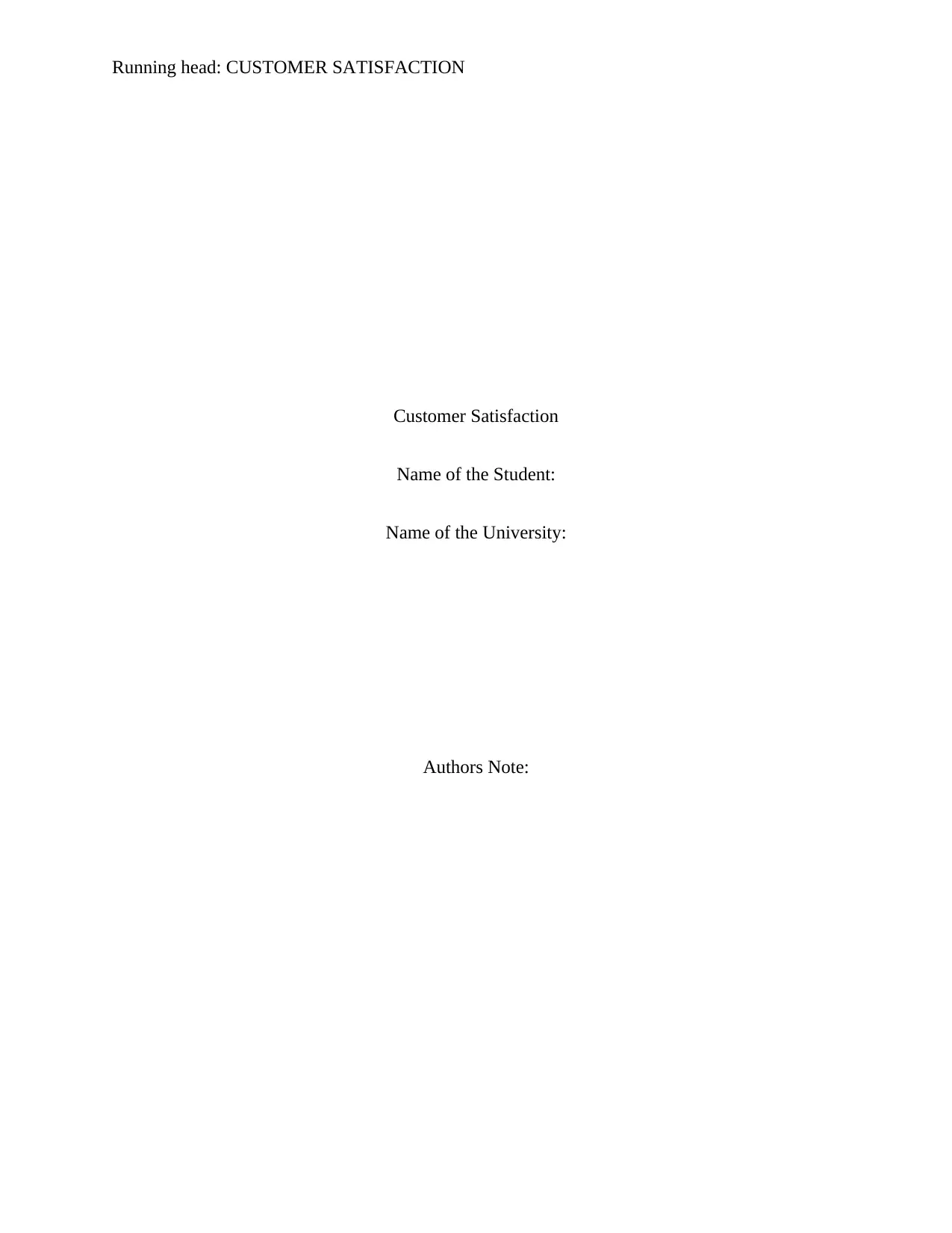
Running head: CUSTOMER SATISFACTION
Customer Satisfaction
Name of the Student:
Name of the University:
Authors Note:
Customer Satisfaction
Name of the Student:
Name of the University:
Authors Note:
Paraphrase This Document
Need a fresh take? Get an instant paraphrase of this document with our AI Paraphraser
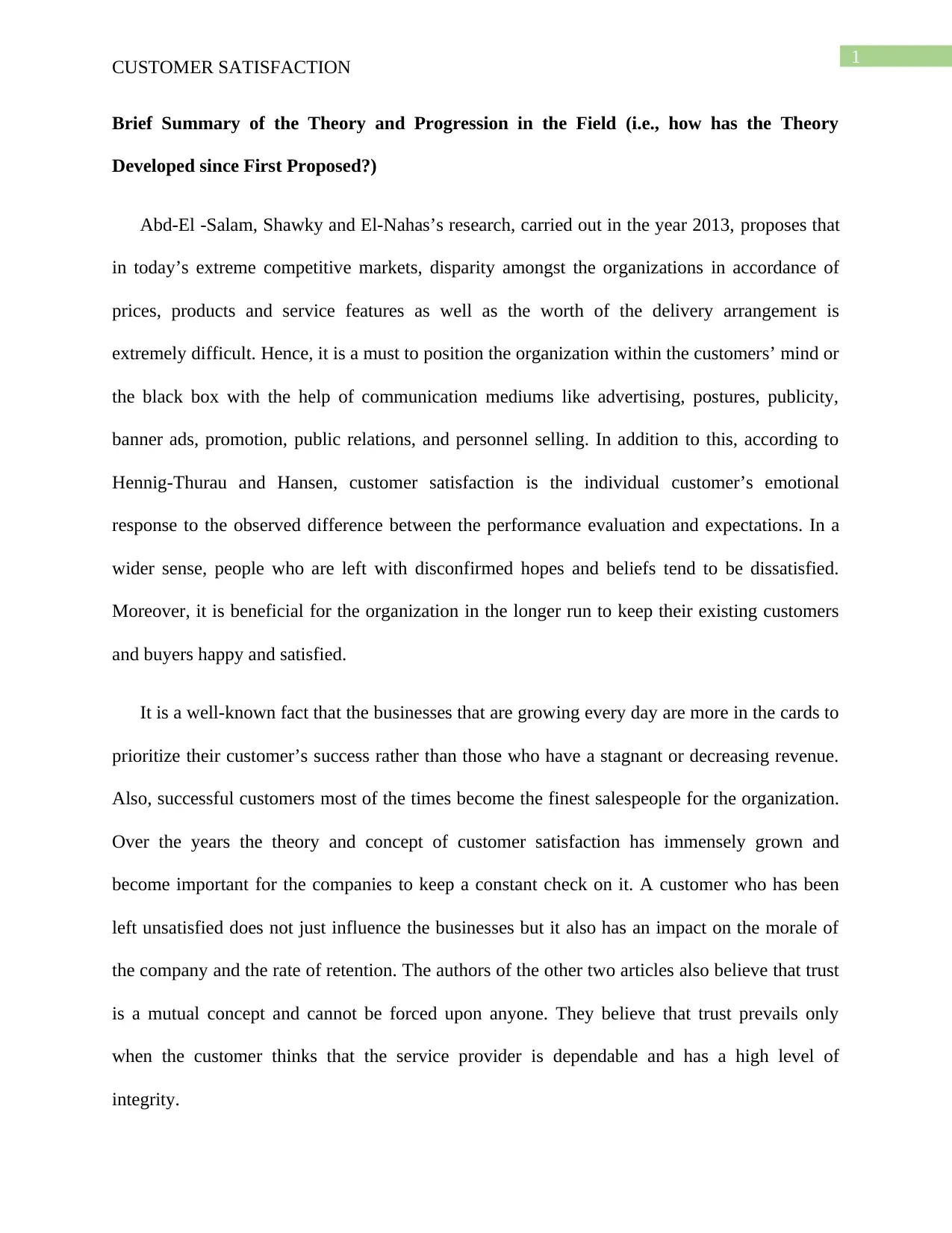
1
CUSTOMER SATISFACTION
Brief Summary of the Theory and Progression in the Field (i.e., how has the Theory
Developed since First Proposed?)
Abd-El -Salam, Shawky and El-Nahas’s research, carried out in the year 2013, proposes that
in today’s extreme competitive markets, disparity amongst the organizations in accordance of
prices, products and service features as well as the worth of the delivery arrangement is
extremely difficult. Hence, it is a must to position the organization within the customers’ mind or
the black box with the help of communication mediums like advertising, postures, publicity,
banner ads, promotion, public relations, and personnel selling. In addition to this, according to
Hennig-Thurau and Hansen, customer satisfaction is the individual customer’s emotional
response to the observed difference between the performance evaluation and expectations. In a
wider sense, people who are left with disconfirmed hopes and beliefs tend to be dissatisfied.
Moreover, it is beneficial for the organization in the longer run to keep their existing customers
and buyers happy and satisfied.
It is a well-known fact that the businesses that are growing every day are more in the cards to
prioritize their customer’s success rather than those who have a stagnant or decreasing revenue.
Also, successful customers most of the times become the finest salespeople for the organization.
Over the years the theory and concept of customer satisfaction has immensely grown and
become important for the companies to keep a constant check on it. A customer who has been
left unsatisfied does not just influence the businesses but it also has an impact on the morale of
the company and the rate of retention. The authors of the other two articles also believe that trust
is a mutual concept and cannot be forced upon anyone. They believe that trust prevails only
when the customer thinks that the service provider is dependable and has a high level of
integrity.
CUSTOMER SATISFACTION
Brief Summary of the Theory and Progression in the Field (i.e., how has the Theory
Developed since First Proposed?)
Abd-El -Salam, Shawky and El-Nahas’s research, carried out in the year 2013, proposes that
in today’s extreme competitive markets, disparity amongst the organizations in accordance of
prices, products and service features as well as the worth of the delivery arrangement is
extremely difficult. Hence, it is a must to position the organization within the customers’ mind or
the black box with the help of communication mediums like advertising, postures, publicity,
banner ads, promotion, public relations, and personnel selling. In addition to this, according to
Hennig-Thurau and Hansen, customer satisfaction is the individual customer’s emotional
response to the observed difference between the performance evaluation and expectations. In a
wider sense, people who are left with disconfirmed hopes and beliefs tend to be dissatisfied.
Moreover, it is beneficial for the organization in the longer run to keep their existing customers
and buyers happy and satisfied.
It is a well-known fact that the businesses that are growing every day are more in the cards to
prioritize their customer’s success rather than those who have a stagnant or decreasing revenue.
Also, successful customers most of the times become the finest salespeople for the organization.
Over the years the theory and concept of customer satisfaction has immensely grown and
become important for the companies to keep a constant check on it. A customer who has been
left unsatisfied does not just influence the businesses but it also has an impact on the morale of
the company and the rate of retention. The authors of the other two articles also believe that trust
is a mutual concept and cannot be forced upon anyone. They believe that trust prevails only
when the customer thinks that the service provider is dependable and has a high level of
integrity.
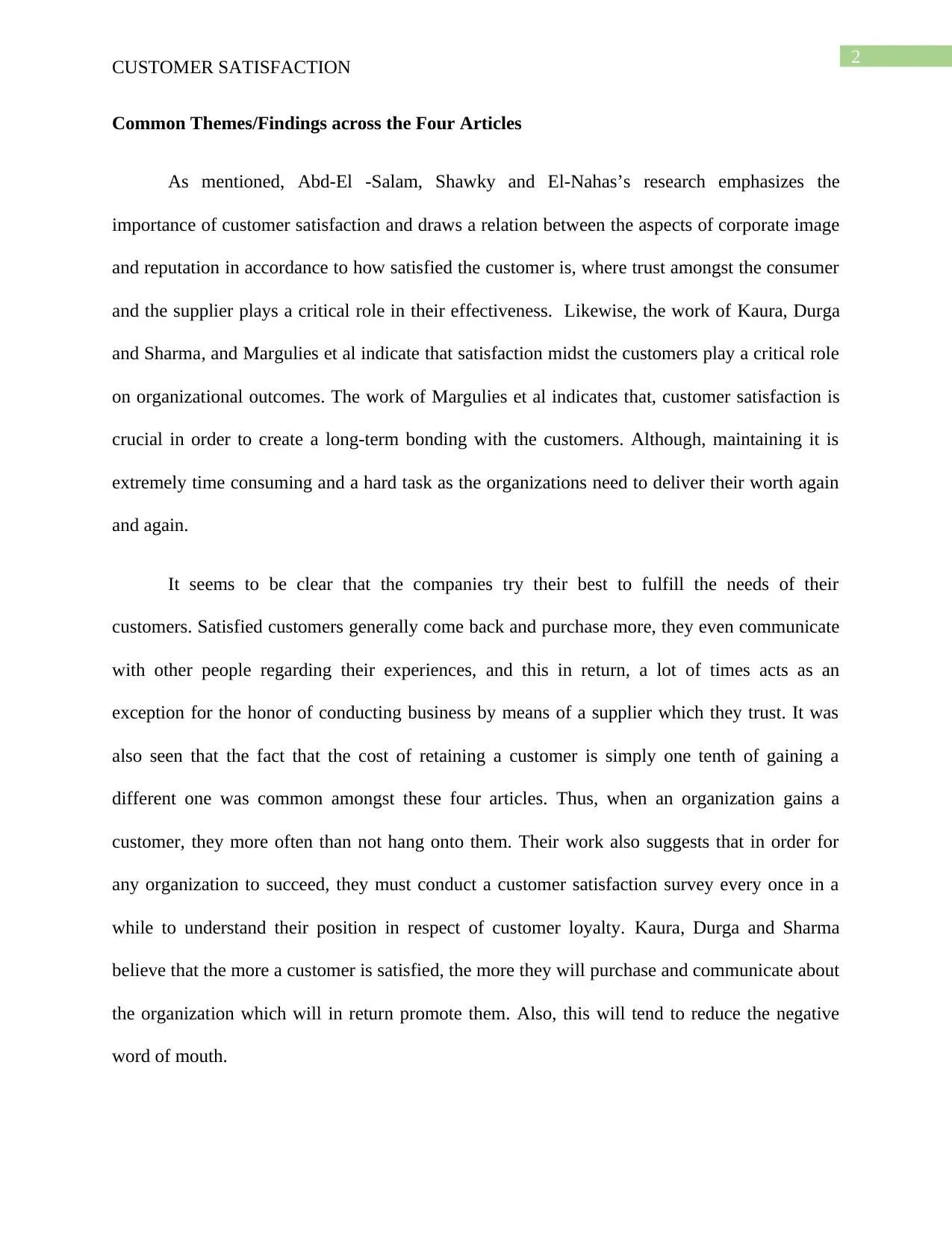
2
CUSTOMER SATISFACTION
Common Themes/Findings across the Four Articles
As mentioned, Abd-El -Salam, Shawky and El-Nahas’s research emphasizes the
importance of customer satisfaction and draws a relation between the aspects of corporate image
and reputation in accordance to how satisfied the customer is, where trust amongst the consumer
and the supplier plays a critical role in their effectiveness. Likewise, the work of Kaura, Durga
and Sharma, and Margulies et al indicate that satisfaction midst the customers play a critical role
on organizational outcomes. The work of Margulies et al indicates that, customer satisfaction is
crucial in order to create a long-term bonding with the customers. Although, maintaining it is
extremely time consuming and a hard task as the organizations need to deliver their worth again
and again.
It seems to be clear that the companies try their best to fulfill the needs of their
customers. Satisfied customers generally come back and purchase more, they even communicate
with other people regarding their experiences, and this in return, a lot of times acts as an
exception for the honor of conducting business by means of a supplier which they trust. It was
also seen that the fact that the cost of retaining a customer is simply one tenth of gaining a
different one was common amongst these four articles. Thus, when an organization gains a
customer, they more often than not hang onto them. Their work also suggests that in order for
any organization to succeed, they must conduct a customer satisfaction survey every once in a
while to understand their position in respect of customer loyalty. Kaura, Durga and Sharma
believe that the more a customer is satisfied, the more they will purchase and communicate about
the organization which will in return promote them. Also, this will tend to reduce the negative
word of mouth.
CUSTOMER SATISFACTION
Common Themes/Findings across the Four Articles
As mentioned, Abd-El -Salam, Shawky and El-Nahas’s research emphasizes the
importance of customer satisfaction and draws a relation between the aspects of corporate image
and reputation in accordance to how satisfied the customer is, where trust amongst the consumer
and the supplier plays a critical role in their effectiveness. Likewise, the work of Kaura, Durga
and Sharma, and Margulies et al indicate that satisfaction midst the customers play a critical role
on organizational outcomes. The work of Margulies et al indicates that, customer satisfaction is
crucial in order to create a long-term bonding with the customers. Although, maintaining it is
extremely time consuming and a hard task as the organizations need to deliver their worth again
and again.
It seems to be clear that the companies try their best to fulfill the needs of their
customers. Satisfied customers generally come back and purchase more, they even communicate
with other people regarding their experiences, and this in return, a lot of times acts as an
exception for the honor of conducting business by means of a supplier which they trust. It was
also seen that the fact that the cost of retaining a customer is simply one tenth of gaining a
different one was common amongst these four articles. Thus, when an organization gains a
customer, they more often than not hang onto them. Their work also suggests that in order for
any organization to succeed, they must conduct a customer satisfaction survey every once in a
while to understand their position in respect of customer loyalty. Kaura, Durga and Sharma
believe that the more a customer is satisfied, the more they will purchase and communicate about
the organization which will in return promote them. Also, this will tend to reduce the negative
word of mouth.
⊘ This is a preview!⊘
Do you want full access?
Subscribe today to unlock all pages.

Trusted by 1+ million students worldwide
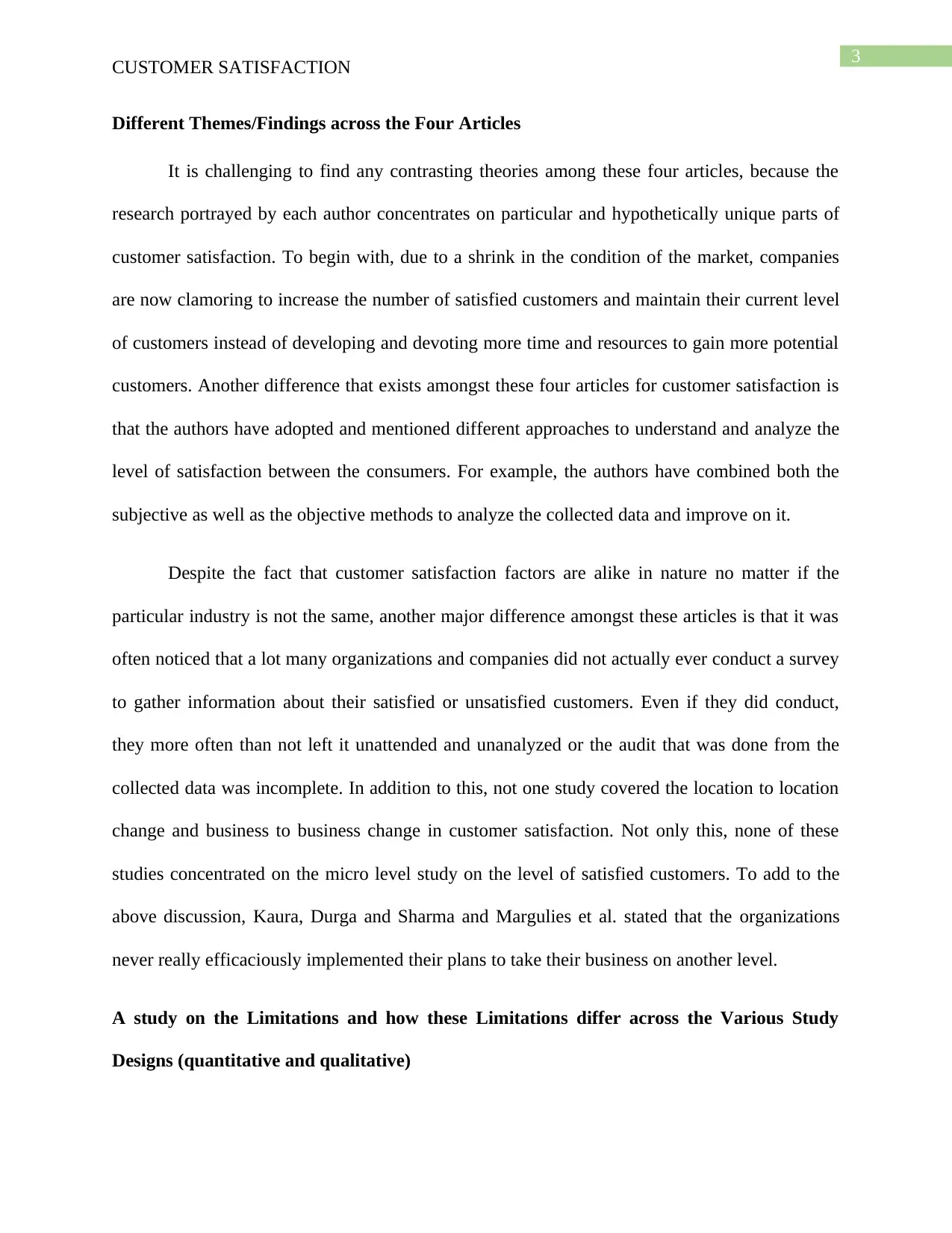
3
CUSTOMER SATISFACTION
Different Themes/Findings across the Four Articles
It is challenging to find any contrasting theories among these four articles, because the
research portrayed by each author concentrates on particular and hypothetically unique parts of
customer satisfaction. To begin with, due to a shrink in the condition of the market, companies
are now clamoring to increase the number of satisfied customers and maintain their current level
of customers instead of developing and devoting more time and resources to gain more potential
customers. Another difference that exists amongst these four articles for customer satisfaction is
that the authors have adopted and mentioned different approaches to understand and analyze the
level of satisfaction between the consumers. For example, the authors have combined both the
subjective as well as the objective methods to analyze the collected data and improve on it.
Despite the fact that customer satisfaction factors are alike in nature no matter if the
particular industry is not the same, another major difference amongst these articles is that it was
often noticed that a lot many organizations and companies did not actually ever conduct a survey
to gather information about their satisfied or unsatisfied customers. Even if they did conduct,
they more often than not left it unattended and unanalyzed or the audit that was done from the
collected data was incomplete. In addition to this, not one study covered the location to location
change and business to business change in customer satisfaction. Not only this, none of these
studies concentrated on the micro level study on the level of satisfied customers. To add to the
above discussion, Kaura, Durga and Sharma and Margulies et al. stated that the organizations
never really efficaciously implemented their plans to take their business on another level.
A study on the Limitations and how these Limitations differ across the Various Study
Designs (quantitative and qualitative)
CUSTOMER SATISFACTION
Different Themes/Findings across the Four Articles
It is challenging to find any contrasting theories among these four articles, because the
research portrayed by each author concentrates on particular and hypothetically unique parts of
customer satisfaction. To begin with, due to a shrink in the condition of the market, companies
are now clamoring to increase the number of satisfied customers and maintain their current level
of customers instead of developing and devoting more time and resources to gain more potential
customers. Another difference that exists amongst these four articles for customer satisfaction is
that the authors have adopted and mentioned different approaches to understand and analyze the
level of satisfaction between the consumers. For example, the authors have combined both the
subjective as well as the objective methods to analyze the collected data and improve on it.
Despite the fact that customer satisfaction factors are alike in nature no matter if the
particular industry is not the same, another major difference amongst these articles is that it was
often noticed that a lot many organizations and companies did not actually ever conduct a survey
to gather information about their satisfied or unsatisfied customers. Even if they did conduct,
they more often than not left it unattended and unanalyzed or the audit that was done from the
collected data was incomplete. In addition to this, not one study covered the location to location
change and business to business change in customer satisfaction. Not only this, none of these
studies concentrated on the micro level study on the level of satisfied customers. To add to the
above discussion, Kaura, Durga and Sharma and Margulies et al. stated that the organizations
never really efficaciously implemented their plans to take their business on another level.
A study on the Limitations and how these Limitations differ across the Various Study
Designs (quantitative and qualitative)
Paraphrase This Document
Need a fresh take? Get an instant paraphrase of this document with our AI Paraphraser
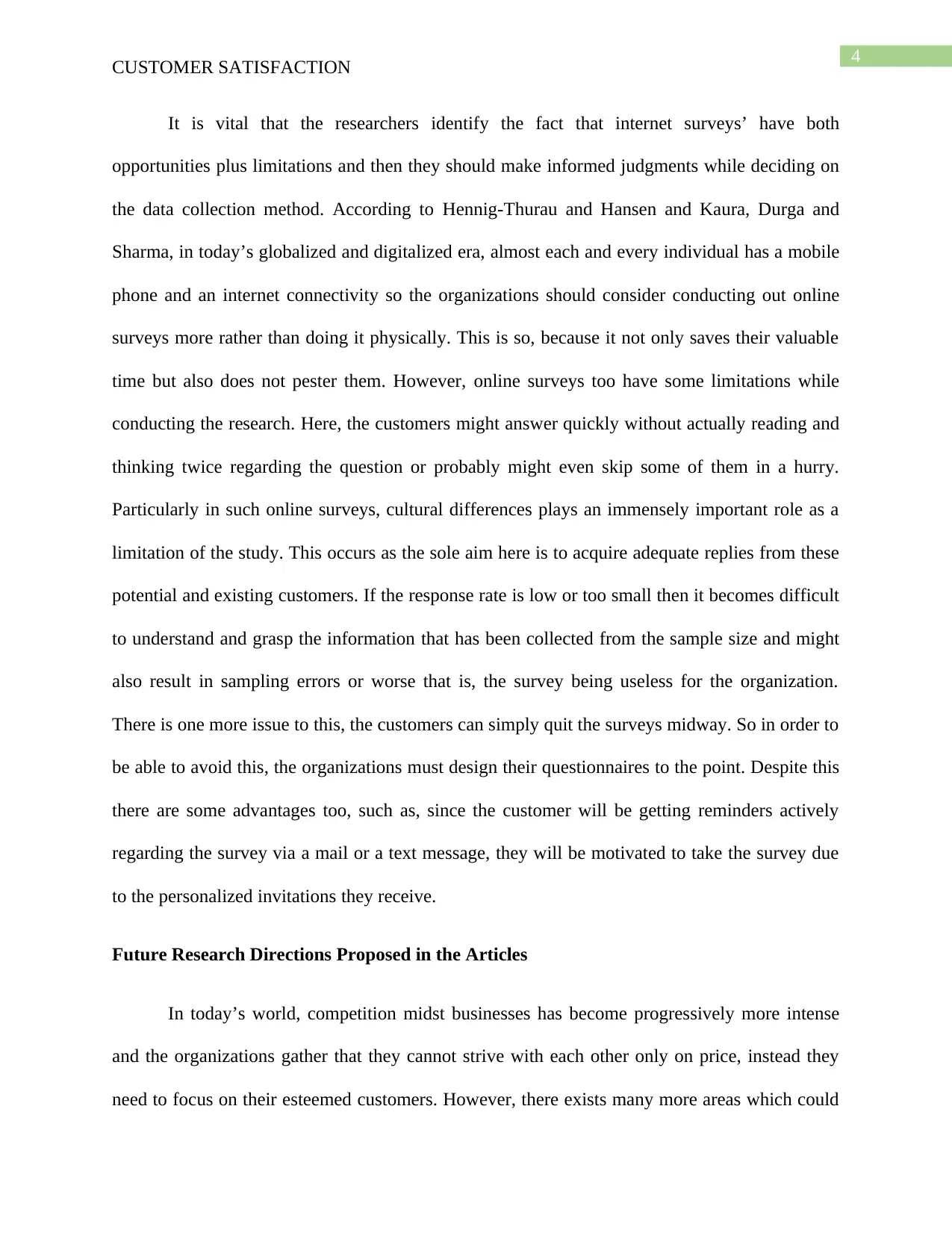
4
CUSTOMER SATISFACTION
It is vital that the researchers identify the fact that internet surveys’ have both
opportunities plus limitations and then they should make informed judgments while deciding on
the data collection method. According to Hennig-Thurau and Hansen and Kaura, Durga and
Sharma, in today’s globalized and digitalized era, almost each and every individual has a mobile
phone and an internet connectivity so the organizations should consider conducting out online
surveys more rather than doing it physically. This is so, because it not only saves their valuable
time but also does not pester them. However, online surveys too have some limitations while
conducting the research. Here, the customers might answer quickly without actually reading and
thinking twice regarding the question or probably might even skip some of them in a hurry.
Particularly in such online surveys, cultural differences plays an immensely important role as a
limitation of the study. This occurs as the sole aim here is to acquire adequate replies from these
potential and existing customers. If the response rate is low or too small then it becomes difficult
to understand and grasp the information that has been collected from the sample size and might
also result in sampling errors or worse that is, the survey being useless for the organization.
There is one more issue to this, the customers can simply quit the surveys midway. So in order to
be able to avoid this, the organizations must design their questionnaires to the point. Despite this
there are some advantages too, such as, since the customer will be getting reminders actively
regarding the survey via a mail or a text message, they will be motivated to take the survey due
to the personalized invitations they receive.
Future Research Directions Proposed in the Articles
In today’s world, competition midst businesses has become progressively more intense
and the organizations gather that they cannot strive with each other only on price, instead they
need to focus on their esteemed customers. However, there exists many more areas which could
CUSTOMER SATISFACTION
It is vital that the researchers identify the fact that internet surveys’ have both
opportunities plus limitations and then they should make informed judgments while deciding on
the data collection method. According to Hennig-Thurau and Hansen and Kaura, Durga and
Sharma, in today’s globalized and digitalized era, almost each and every individual has a mobile
phone and an internet connectivity so the organizations should consider conducting out online
surveys more rather than doing it physically. This is so, because it not only saves their valuable
time but also does not pester them. However, online surveys too have some limitations while
conducting the research. Here, the customers might answer quickly without actually reading and
thinking twice regarding the question or probably might even skip some of them in a hurry.
Particularly in such online surveys, cultural differences plays an immensely important role as a
limitation of the study. This occurs as the sole aim here is to acquire adequate replies from these
potential and existing customers. If the response rate is low or too small then it becomes difficult
to understand and grasp the information that has been collected from the sample size and might
also result in sampling errors or worse that is, the survey being useless for the organization.
There is one more issue to this, the customers can simply quit the surveys midway. So in order to
be able to avoid this, the organizations must design their questionnaires to the point. Despite this
there are some advantages too, such as, since the customer will be getting reminders actively
regarding the survey via a mail or a text message, they will be motivated to take the survey due
to the personalized invitations they receive.
Future Research Directions Proposed in the Articles
In today’s world, competition midst businesses has become progressively more intense
and the organizations gather that they cannot strive with each other only on price, instead they
need to focus on their esteemed customers. However, there exists many more areas which could
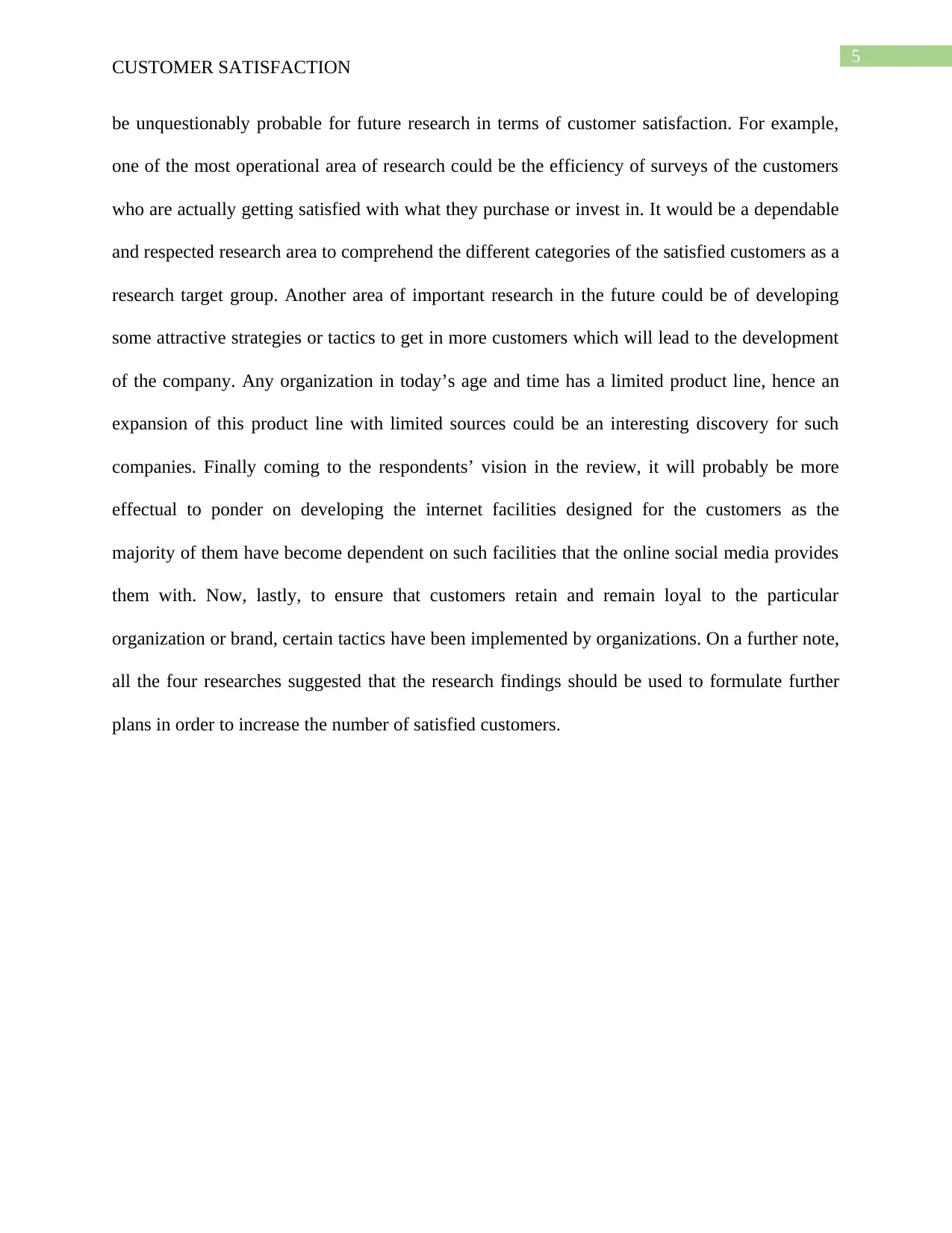
5
CUSTOMER SATISFACTION
be unquestionably probable for future research in terms of customer satisfaction. For example,
one of the most operational area of research could be the efficiency of surveys of the customers
who are actually getting satisfied with what they purchase or invest in. It would be a dependable
and respected research area to comprehend the different categories of the satisfied customers as a
research target group. Another area of important research in the future could be of developing
some attractive strategies or tactics to get in more customers which will lead to the development
of the company. Any organization in today’s age and time has a limited product line, hence an
expansion of this product line with limited sources could be an interesting discovery for such
companies. Finally coming to the respondents’ vision in the review, it will probably be more
effectual to ponder on developing the internet facilities designed for the customers as the
majority of them have become dependent on such facilities that the online social media provides
them with. Now, lastly, to ensure that customers retain and remain loyal to the particular
organization or brand, certain tactics have been implemented by organizations. On a further note,
all the four researches suggested that the research findings should be used to formulate further
plans in order to increase the number of satisfied customers.
CUSTOMER SATISFACTION
be unquestionably probable for future research in terms of customer satisfaction. For example,
one of the most operational area of research could be the efficiency of surveys of the customers
who are actually getting satisfied with what they purchase or invest in. It would be a dependable
and respected research area to comprehend the different categories of the satisfied customers as a
research target group. Another area of important research in the future could be of developing
some attractive strategies or tactics to get in more customers which will lead to the development
of the company. Any organization in today’s age and time has a limited product line, hence an
expansion of this product line with limited sources could be an interesting discovery for such
companies. Finally coming to the respondents’ vision in the review, it will probably be more
effectual to ponder on developing the internet facilities designed for the customers as the
majority of them have become dependent on such facilities that the online social media provides
them with. Now, lastly, to ensure that customers retain and remain loyal to the particular
organization or brand, certain tactics have been implemented by organizations. On a further note,
all the four researches suggested that the research findings should be used to formulate further
plans in order to increase the number of satisfied customers.
⊘ This is a preview!⊘
Do you want full access?
Subscribe today to unlock all pages.

Trusted by 1+ million students worldwide
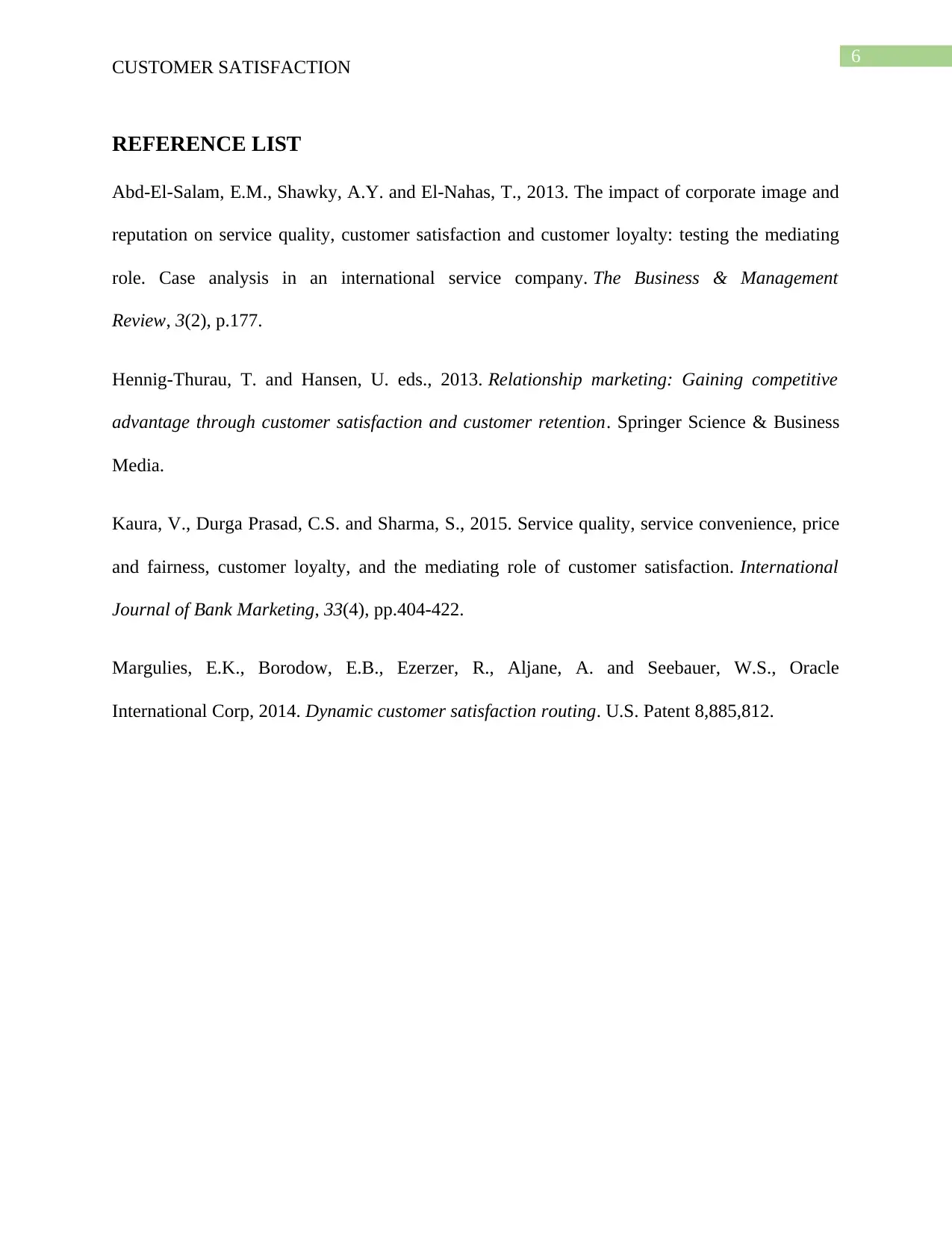
6
CUSTOMER SATISFACTION
REFERENCE LIST
Abd-El-Salam, E.M., Shawky, A.Y. and El-Nahas, T., 2013. The impact of corporate image and
reputation on service quality, customer satisfaction and customer loyalty: testing the mediating
role. Case analysis in an international service company. The Business & Management
Review, 3(2), p.177.
Hennig-Thurau, T. and Hansen, U. eds., 2013. Relationship marketing: Gaining competitive
advantage through customer satisfaction and customer retention. Springer Science & Business
Media.
Kaura, V., Durga Prasad, C.S. and Sharma, S., 2015. Service quality, service convenience, price
and fairness, customer loyalty, and the mediating role of customer satisfaction. International
Journal of Bank Marketing, 33(4), pp.404-422.
Margulies, E.K., Borodow, E.B., Ezerzer, R., Aljane, A. and Seebauer, W.S., Oracle
International Corp, 2014. Dynamic customer satisfaction routing. U.S. Patent 8,885,812.
CUSTOMER SATISFACTION
REFERENCE LIST
Abd-El-Salam, E.M., Shawky, A.Y. and El-Nahas, T., 2013. The impact of corporate image and
reputation on service quality, customer satisfaction and customer loyalty: testing the mediating
role. Case analysis in an international service company. The Business & Management
Review, 3(2), p.177.
Hennig-Thurau, T. and Hansen, U. eds., 2013. Relationship marketing: Gaining competitive
advantage through customer satisfaction and customer retention. Springer Science & Business
Media.
Kaura, V., Durga Prasad, C.S. and Sharma, S., 2015. Service quality, service convenience, price
and fairness, customer loyalty, and the mediating role of customer satisfaction. International
Journal of Bank Marketing, 33(4), pp.404-422.
Margulies, E.K., Borodow, E.B., Ezerzer, R., Aljane, A. and Seebauer, W.S., Oracle
International Corp, 2014. Dynamic customer satisfaction routing. U.S. Patent 8,885,812.
1 out of 7
Your All-in-One AI-Powered Toolkit for Academic Success.
+13062052269
info@desklib.com
Available 24*7 on WhatsApp / Email
![[object Object]](/_next/static/media/star-bottom.7253800d.svg)
Unlock your academic potential
Copyright © 2020–2025 A2Z Services. All Rights Reserved. Developed and managed by ZUCOL.